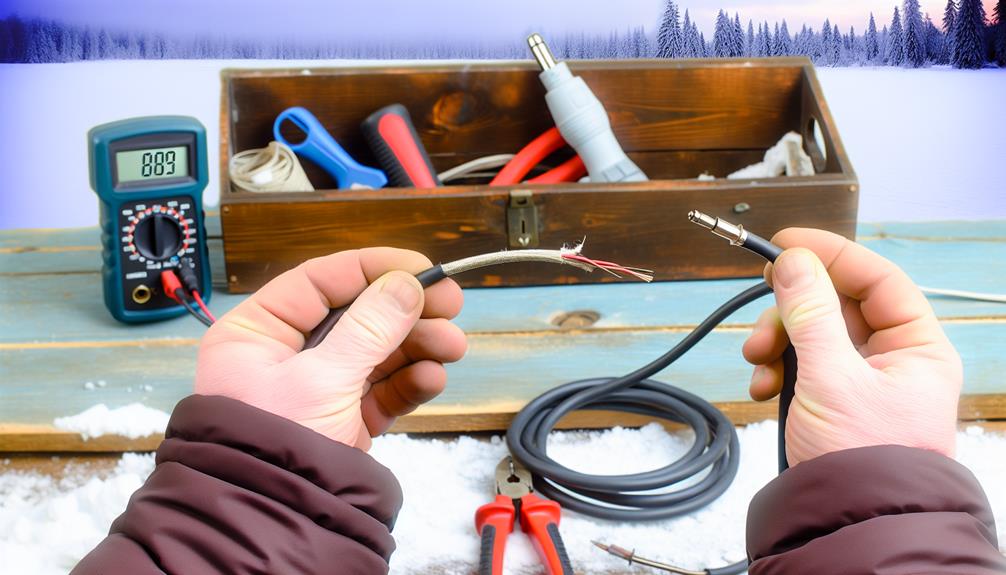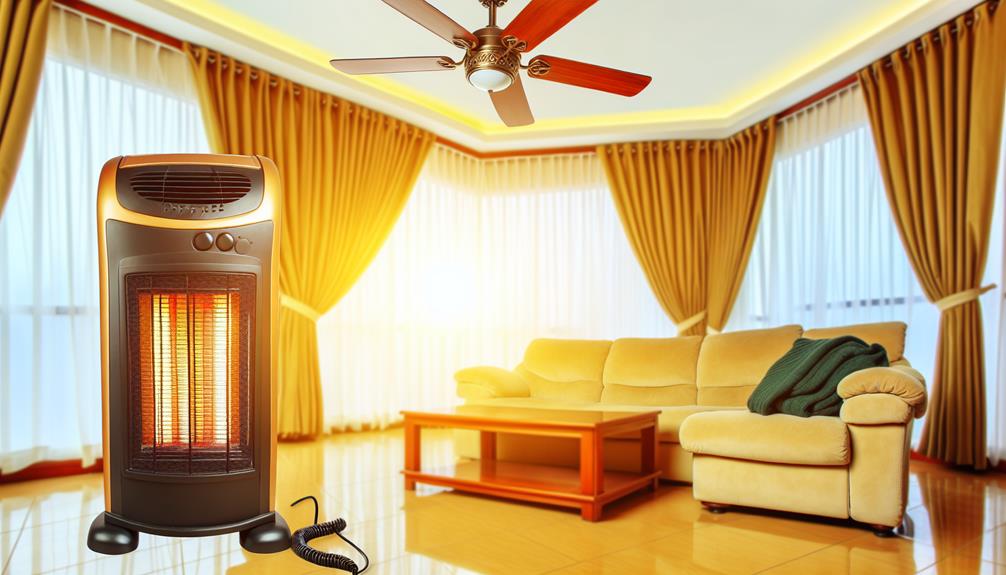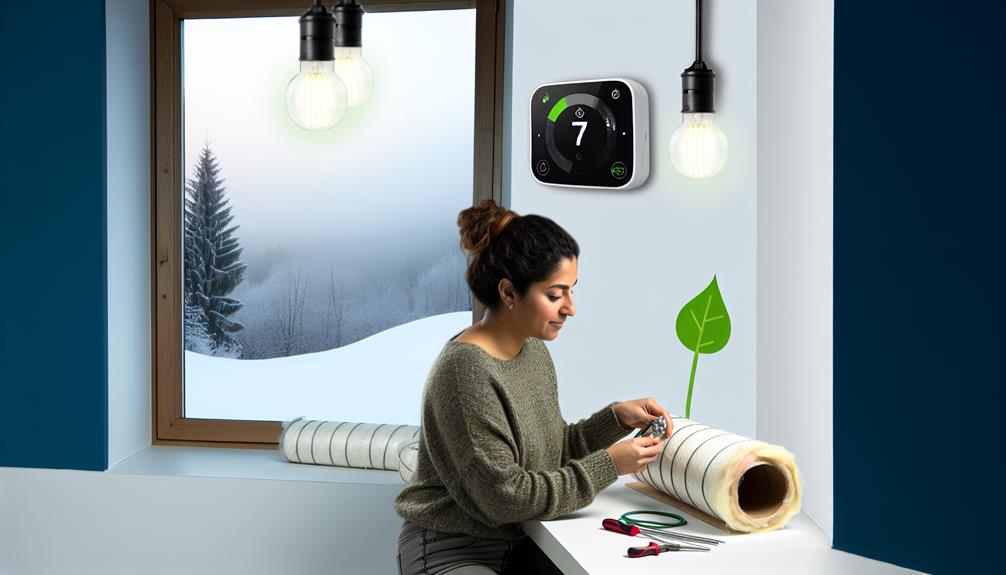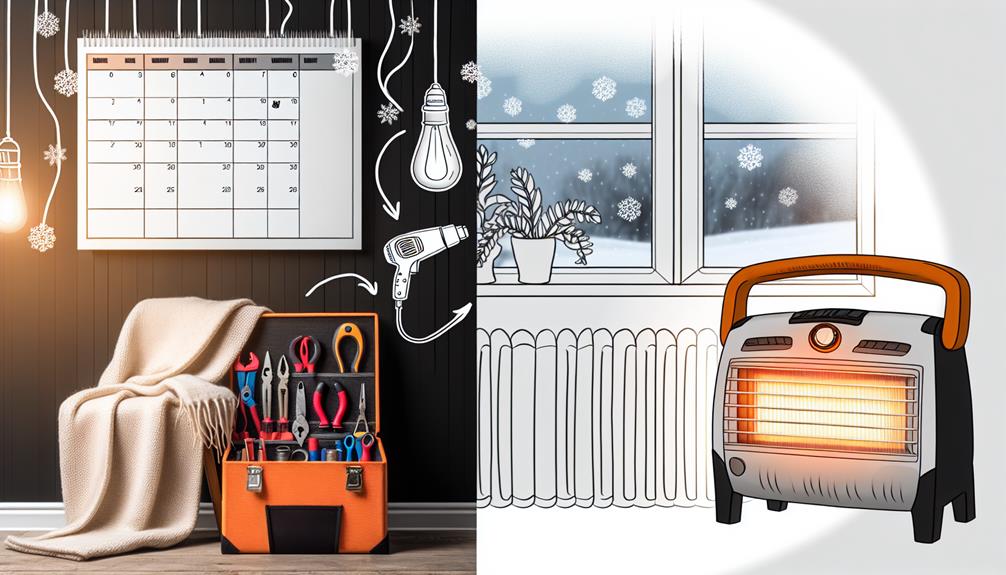As the first whispers of winter brush against your home, it's time to ensure your portable heater is a steadfast companion rather than a fair-weather friend. You've likely relied on it to fend off the chills of past cold seasons, but are you aware of the steps needed to keep it running efficiently and safely? From inspecting its physical condition to understanding the nuances of its operation, you'll want to take a closer look at the maintenance rituals that could extend its life and effectiveness. It's not just about flipping a switch when the frost sets in; it's also about the unseen dangers that could be lurking within neglected components. Stay tuned to uncover the crucial habits that could shield your cozy evenings from turning into a cold discomfort or, worse, a hazardous situation.
Key Takeaways
- Inspect the heater for any visible damage or functional issues promptly
- Regularly clean and maintain the heater to prevent debris accumulation and ensure smooth operation
- Inspect the electrical cords for any signs of wear or damage and seek professional servicing for any compromised cords
- Test the safety features of the heater, such as the tip-over switch and overheating sensor, and ensure proper heat distribution by positioning the heater appropriately.
Assessing Heater Condition
Before firing up your portable heater for warmth, inspect it carefully for any visible damage, such as dents or dings, to ensure it's in safe working condition. Look over the power cord for signs of wear such as fraying or cracking, as these can be fire hazards. If the cord is worn or damaged, do not use the heater until it's been repaired by a professional.
Check that the switch operates smoothly and doesn't stick or malfunction, which could indicate internal issues. It's vital that all heating equipment undergoes recognized testing to verify safety standards. If there's any doubt about the integrity of your heater, consult the manufacturer's guidelines or seek expert advice.
Examine the heater's overall condition, including grilles and vents, for any accumulation of dust or debris that could impede performance or pose a risk. Regular maintenance not only extends the life of your heater but also ensures it operates efficiently.
If you notice any visible damage or functional issues that may affect the heater's performance, address these problems promptly. Remember, the effectiveness and safety of your heating equipment rely on your proactive approach to maintenance and care.
Cleaning and Dusting
To maintain your portable heater's efficiency and safety, regularly dust its exterior to prevent the accumulation of debris. Dust and dirt can hinder performance and pose a fire risk, so it's crucial to keep your space heater clean.
Use a soft brush or a vacuum with a brush attachment to gently clean the heater's vents and grills. This will ensure that airflow isn't obstructed, which is vital for efficient operation and space heater safety. After removing loose dust, wipe down the surface with a slightly damp cloth to get rid of any remaining dirt or grime. However, make sure the heater is completely cool and unplugged before you start cleaning it.
It's also essential to keep the air intake clear. A clogged air intake can cause the heater to overheat, reducing its lifespan and increasing safety risks. Lastly, don't overlook the control panel and switches—clean any visible dust or dirt to guarantee smooth operation.
Here's a quick reference table for your cleaning routine:
| Area to Clean | Tool to Use |
|---|---|
| Vents and Grills | Soft brush/Vacuum attachment |
| Surface | Damp cloth |
| Control Panel | Dry cloth |
Regular cleaning and dusting of your portable heater will not only extend its life but also keep it running safely and effectively throughout the winter.
Inspecting Electrical Cords

After ensuring your portable heater is free of dust and debris, it's essential to examine the electrical cords for any signs of wear or damage. Start by checking the entire length of the cord for fraying, cuts, or any visible deterioration. It's crucial to recognize that a damaged cord can pose a significant fire hazard, so handle this inspection with care.
While inspecting, also ensure that you never run the power cord under rugs or carpeting. This practice not only poses a tripping hazard but also can cause the cord to overheat without your knowledge. Keep the cord visible so you can monitor it for signs of overheating, such as discoloration or a melting insulation.
If you notice any damage, it's not the time for DIY repairs—seek professional servicing immediately. Using a heater with a compromised cord is dangerous and could lead to electrical fires.
Testing Safety Features
Ensure your portable heater's safety features function correctly by testing the tip-over switch and overheating sensor before regular winter use. These checks are vital to ensure that your heater won't become a hazard during those cold months.
- Testing Safety Features:
- Tip-over Switch:
- Gently push the heater to make sure it switches off if it tips.
- Confirm the heater's low center of gravity keeps it stable.
- Overheating Sensor:
- Activate the sensor to verify the heater shuts off at high temperatures.
- Check that the thermostat and control mechanism respond appropriately.
Remember, these tests are practical measures to prevent potential accidents. Always have working smoke alarms in the area where you're using the heater and never leave the heater unattended while in operation.
Regular maintenance, including the evaluation of safety features, is not just a technicality; it's a necessity. It's about the practical steps you take to protect yourself and your loved ones. By ensuring these features work properly, you're setting the stage for a safe, warm winter with the confidence that your portable heater is ready to perform.
Optimizing Heat Distribution

To maximize your heater's effectiveness, it's crucial to position it strategically in your space. You'll need to facilitate the circulation of warm air to avoid cold spots, ensuring the entire room benefits from the heat. Additionally, keep the area around your heater clear to prevent obstructions that can impede heat flow and distribution.
Strategic Heater Placement
For optimal heat distribution, position your portable heater in a central location, away from furniture and other obstructions that may hinder airflow. Ensure your space heater is at least three feet from anything that can burn, such as curtains or bedding. Place the heater on a hard, non-flammable surface for stability and safety.
- Maximize Heater Efficiency:
- Central positioning: Equidistant from walls
- Elevated placement: Warm air descends, spreading heat evenly
- Safety Precautions:
- Clear zone: At least three feet from combustibles
- Stable surface: Heater on a hard, level area
Circulating Warm Air
While using a portable heater, incorporating a fan can significantly enhance the circulation of warm air, ensuring it spreads evenly throughout the room. Place your heater near a wall to optimize heat distribution; this strategic positioning allows for an even dispersion of warmth. Additionally, using a ceiling fan on a low setting can effectively push warm air down, preventing it from accumulating at the ceiling. To facilitate free airflow, keep doors open between rooms, allowing heat to circulate throughout your space. It's also practical to position the heater centrally to maximize heating efficiency. Remember, never leave a space heater unattended, and always practice fire safety by turning it off if you leave the room.
Reducing Heat Obstructions
Building on the concept of air circulation, ensuring your heater's vents or registers are free from dust is crucial for optimizing heat distribution. Here's what you need to do:
- Dust vents or registers
- Use a vacuum with a brush attachment to gently remove dust
- Wipe with a damp cloth to capture any remaining particles
- Clear space around space heaters
- Maintain at least three feet of clearance for fire safety
- Remove objects that could catch fire, ensuring nothing is above or too close to the heater
This not only improves air quality but also enhances heating efficiency. Remember, unobstructed airflow is key, and fire safety is paramount—always keep your space heaters clear of potential hazards.
Energy Efficiency Practices

To boost your portable heater's efficiency, optimize its thermostat settings to balance comfort with energy savings. Establish a regular cleaning schedule to maintain airflow and heater performance, preventing energy waste. Place your heater strategically in the room to maximize heat distribution without overworking the unit.
Optimize Thermostat Settings
You can significantly reduce your heating bills by optimizing your thermostat settings, a practical step to maintain energy efficiency during the colder months. Here's how to adjust settings for maximum benefit:
- During the Day:
- Lower the temperature when the house is empty.
- Use supplemental heat from space heaters in occupied rooms only.
- At Night:
- Set the thermostat to a lower temperature while you're under the blankets.
- Layer clothing to stay warm without cranking up the heat.
Investing in a programmable or smart thermostat can automate these adjustments, tailoring the climate to your schedule and the winter weather. This not only trims your energy costs but also extends the life of your heating system by reducing excessive use.
Regular Cleaning Schedule
While optimizing your thermostat settings is a key step, maintaining a regular cleaning schedule for your portable heater is equally critical for energy efficiency. Dust and debris can accumulate on your heater's exterior and interior components, including vents and grills, which impedes proper airflow and reduces heating efficiency. By establishing a regular cleaning routine, you'll ensure optimal performance and contribute to fire safety, reducing the risk of home heating fires.
Regularly vacuum or wipe down your portable space heaters to remove any buildup. Don't forget to clean or replace the filters as the manufacturer recommends. Additionally, scheduling professional maintenance at least once a year can keep your heater running smoothly throughout the winter months.
Strategic Heater Placement
Maximizing your portable heater's efficiency involves strategic placement in areas with ample air circulation, ensuring it isn't near windows or doors where heat can escape. Here's how you should position your space heaters:
- Optimal Location:
- *Central Placement*: In the room's center for uniform heat distribution.
- *Reflective Backing*: Use a reflective surface to bounce heat into the living space.
- Safety Precautions:
- *Clearance*: Keep heaters at least three feet from flammable materials.
- *Vigilance*: Never leave it unattended or on while leaving a room for fire safety.
Scheduling Regular Maintenance

To ensure optimal performance and safety, it's essential to schedule regular maintenance for your portable heater before the onset of winter. Neglecting this critical step increases the risk of malfunctions that could lead to safety hazards, including fires. Begin by inspecting your space heaters for any signs of wear or damage, focusing on power cords and heating elements. If you identify frayed wires or corrosion, it's time to repair or replace the unit.
Implement a maintenance routine that includes cleaning or replacing filters, as clogged filters not only impair efficiency but also pose a fire risk. Ensure you're familiar with the manufacturer's guidelines for your specific model. Dust and debris accumulation is another common issue that impedes performance; therefore, regularly vacuum the intake and exhaust vents to maintain proper airflow.
For electric space heaters, check the thermostat and automatic shut-off mechanisms to confirm they're functioning correctly. These features are pivotal for preventing overheating and potential fires. It's advisable to have a professional inspect your heater annually, ideally before heavy usage periods. This proactive approach not only secures your safety but also extends the life of your heater, providing you with reliable warmth throughout the coldest months.
Frequently Asked Questions
How Do You Maintain a Portable Heater?
To keep your cozy companion in top shape, you'll want to tackle heater cleaning first. Gently remove dust and debris, ensuring proper airflow. Next, filter replacement is crucial for maintaining air quality. Don't overlook cord inspection; check for any wear that could spell trouble. Lastly, thermostat calibration is key to accurate temperature control. Stick to these steps for practical, technical upkeep, ensuring your heater's longevity and efficiency.
Do Portable Gas Heaters Need Servicing?
Yes, your portable gas heater needs servicing. This ensures the fuel inspection process catches any leaks, reducing carbon monoxide risks. It's also crucial to check ventilation requirements for safety. Stay informed about manufacturer recalls to address potential defects. Servicing isn't just a safety measure; it's a practical way to maintain efficiency and prolong your heater's life. Regular checks by a professional can keep you warm and safe all winter long.
Should Space Heaters Be Unplugged When Not in Use?
Yes, you should always unplug your space heater when it's not in use. It's better to be safe than sorry, considering fire safety and energy conservation. Unplugging reduces outlet strain and eliminates a potential trip hazard. This simple act is a practical step toward ensuring your safety and maintaining your device's longevity. Remember, an ounce of prevention is worth a pound of cure, especially with electrical appliances.
Is It OK to Leave Portable Heater on All Night?
No, you shouldn't leave your portable heater on all night due to fire hazards. Overnight safety is compromised as unattended heaters can cause fires. Additionally, it's not energy-efficient; it uses more electricity and can disrupt your sleep with noise or excessive warmth. Always turn off your heater before bed, and ensure it's equipped with safety features like tip-over switches and overheating sensors for added protection.
